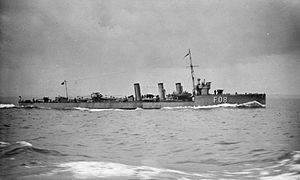
| |
| History | |
|---|---|
| Name | HMS Onslaught |
| Ordered | November 1914 |
| Builder | Fairfield, Govan |
| Launched | 4 December 1915 |
| Completed | 3 March 1916 |
| Out of service | 30 October 1921 |
| Fate | Sold to be broken up |
| General characteristics | |
| Class and type | Admiralty M-class destroyer |
| Displacement | |
| Length | 265 ft (80.77 m) p.p. |
| Beam | 26 ft 9 in (8.15 m) |
| Draught | 16 ft 3 in (4.95 m) |
| Installed power | 3 Yarrow boilers 25,000 shp (19,000 kW) |
| Propulsion | 2 Brown-Curtis steam turbines, 2 shafts |
| Speed | 34 knots (63.0 km/h; 39.1 mph) |
| Range | 3,450 nmi (6,390 km; 3,970 mi) at 15 kn (28 km/h; 17 mph) |
| Complement | 76 |
| Armament |
|
HMS Onslaught was a Admiralty M-class destroyer which served with the Royal Navy during the First World War. The M class were an improvement on the previous L-class, capable of higher speed. The vessel, launched in 1915, joined the Twelfth Destroyer Flotilla under the flotilla leader Faulknor. The ship saw action during the Battle of Jutland in May 1916, jointly sinking the German torpedo boat SMS V48 and launching the torpedo that sank the pre-dreadnought battleship Pommern, the only German battleship to be lost in the battle. Subsequently, the destroyer acted as an escort to other naval ships during the Action of 19 August 1916 and took part in anti-submarine operations. At the end of the war, Onslaught was withdrawn from service and, in 1921, sold to be broken up.